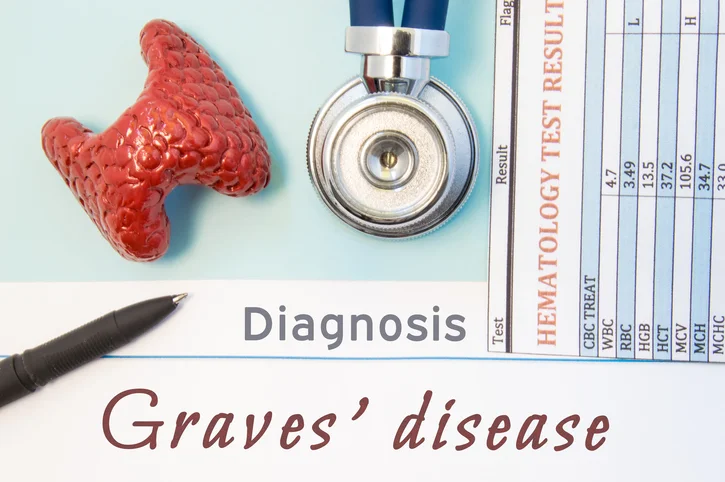Graves’ disease – a common form of hyperthyroidism
/Graves’ disease – a common form of hyperthyroidism
Graves’ disease may not be well known or understood but talk show host Wendy Williams has overnight amplified this condition’s internet hits. Williams, age 53, announced on her TV show that she has been diagnosed with this autoimmune disease that affects the thyroid.
Graves’ disease, named after Robert Graves, an Irish physician discovering the condition about 150 years ago, has the distinction of being the most common form of hyperthyroidism. This disease runs in families and is 7-8 times more common in women than men.
Thyroid disease in general, is a common condition with a lifetime incidence of around 12% in the United States. Women tend to have more thyroid problems than men and it is estimated that around 2 to 3 % of the population will develop hyperthyroidism sometime during their lifetime.
What is hyperthyroidism?
Hyperthyroidism is a condition in which the thyroid gland is overactive making an excessive amount of thyroid hormone. Located in the front of your neck, the thyroid gland releases hormones controlling your metabolism or the rate at which you burn calories. This involves your breathing, heart rate, nervous system, weight, body temperature, along with other functions in the body.
What are the symptoms of Graves’ disease?
Primary symptoms of Graves’ disease are caused by the excessive production of thyroid hormones by the thyroid gland. When the thyroid gland is overactive or ‘hyper,’ victims can have the following symptoms:
· Racing heartbeat
· Hand tremors
· Trouble sleeping
· Weight loss
· Muscle weakness
· Neuropsychiatric symptoms
· Heat intolerance
One of the more noticeable features in those with Graves’ disease is inflammation of the eyes or a swelling of the tissues around the eyes which can lead to bulging of the eyes called Graves’ ophthalmopathy. Not everyone with Graves’ disease will develop bulging eyes as only about one third of patients do. Out of that portion of patients, only 5% will have moderate-to-severe inflammation of the eye tissues to cause serious or permanent vision trouble. If a person with Graves’ disease is going to have eye symptoms, it most often begins about six months before or after the diagnosis and rarely occurs long after the disease has been treated.
Another rare but possible symptom of Graves’ disease is the development of a lumpy reddish thickening of the skin in front of the shins known as pretibial myxedema. This skin condition is usually painless and relatively mild.
What causes Graves’ disease?
Graves’ disease is triggered by a process in the body’s immune system. Our immune system normally protects us from foreign invaders such as bacteria and viruses. The immune system’s job is to destroy foreign invaders with substances called antibodies produced by blood cells called lymphocytes. But sometimes our immune system can be tricked into making antibodies that cross react with proteins on our own cells.
In Grave disease, the body is making an antibody called thyroid-stimulating immunoglobulin (TSI) causing the thyroid gland to produce too much thyroid hormone.
How is it diagnosed?
Diagnosis is made through a physical exam, the patient’s symptoms, and blood tests measuring levels of thyroid stimulating hormone (TSH) and thyroid hormones T3 and T4. Factors a doctor will look for are the presence of Graves’ eye disease, a symmetrically enlarged thyroid gland and a family history with thyroid or other autoimmune conditions, including type 1 diabetes, rheumatoid arthritis, pernicious anemia or vitiligo.
How is it treated?
Fortunately there are several treatments for hyperthyroidism. Depending on a person’s age, gender, physical condition, and the underlying cause, will determine which treatment option is best.
· Radioactive iodine
This treatment has been used for over 60 years and has been shown to be usually safe. It is taken by mouth with the thyroid gland absorbing it helping to shrink the gland relieving symptoms within about three to six months. This treatment will slow thyroid activity which can result in an underactive thyroid or hypothyroidism where you may need to take medication every day to replace thyroxine.
· Anti-thyroid medications
Taking these medications will reduce symptoms of hyperthyroidism by preventing the thyroid gland from producing excess amount of hormones. Within about six to twelve weeks, symptoms will usually begin to improve but the total treatment usually continues at least a year or longer. Even though some people will have the symptoms cleared permanently, there are risks associated with this treatment ranging from the medications causing to serious liver damage, allergic reactions, skin rashes, hives, fever, or joint pain.
· Beta blockers
Commonly used to treat high blood pressure, they won’t reduce thyroid levels but they can reduce a rapid heartbeat and prevent palpitations making a person feel better.
· Surgery (thyroidectomy)
If a woman is pregnant, or a person can’t tolerate anti-thyroid drugs or the radioactive iodine therapy, thyroid surgery is another option. The surgery involves removing most of the thyroid gland but there can be risks. It could damage the vocal cords and parathyroid glands which help control the level of calcium in the blood. Since most of the thyroid gland is removed, a person will have to take lifelong medications of levothyroxine (Synthroid or others) to supply the body with normal amounts of thyroid hormone. Removal of the parathyroid gland will also need medication to keep blood calcium levels normal.

